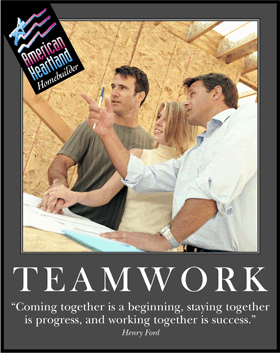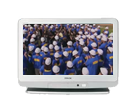Innovative technology is a hot button for buyers when many of us still can't program the clock on our VCR?

Trying to keep up with all the innovation in the products and systems available for today's new homes is a daunting task, like trying to drink from a fire hose. Try for one small sip and you can drown in the torrent of information.
As a result, many builders merely shrug and keep constructing homes the same old way. Besides, consumers aren't rushing to add these kinds of capabilities to their new home. The home is the last low-tech sanctuary from an increasingly technological world. Right? Wrong.
A recent survey (see chart at bottom of page) reveals 60 percent of buyers believe "houses should be built like new cars with computerized controls."" Nearly 64 percent said they would be interested in having "an integrated 'smart house' system."
Rather than just gee-whiz gadgetry, today's consumers are willing to pay more for simplicity and convenience, says Brooke Warrick, president of American Lives, a market research firm that authored the survey. "To gain widespread use, however, a product or a system has to offer a solution to a problem."
Some builders are embracing high-tech solutions with encouraging results, Warrick says. As a consultant to Ladera Ranch, a 6,000-home new community in Orange County, California, Warrick has seen how a high-speed connected infrastructure, including a community intranet, has a strong appeal to today's buyers.
In its latest phase, buyers have been snapping up energy efficient "green" homes, equipped with low VOC paint, photovoltaic panels on the roof and a laundry list of other items. "This adds anywhere from $2.25 to $4 a square foot more to the cost. But we discovered that consumers are willing to pay for these amenities because they offer a clear benefit," Warrick says. "Now they're selling about five of these homes a day. It comes back to perceived value. With Southern California's energy prices, the perceived value is very high since photovoltaic panels will probably pay for themselves in the first year."
NextGen Home
Problem solving technology and affordability were the main motivations behind the 2004 NextGen Demonstration Home, which was on display outside the Las Vegas Convention Center during both the Consumer Electronics Show (CEA) and the International Builders Show. More than 40,000 people toured the 2,400 square foot modular home.
Consumers were extremely enthusiastic about many of its features, while many builders and contractors were less so. "Builders are naturally very skeptical of many new products because they equate it with increased cost," says Paul Barnett, president of iShow, organizer of NextGen. "Our goal was to show that one could incorporate the most advanced technology, as well as the latest in safety and energy efficiency, and still be affordable."
The NextGen home featured more than 120 high-tech products and systems. One of the stars of the home was its control system.
Through the Microsoft® Media Center PC and the My Home application by Custom Home Control, the owner can control... well, just about everything. With the media center, you can take your favorite shows or music with you on your laptop.
And with the control center, homeowners can manage lighting, heating and air, the security system, music throughout the house, security cameras, the pool system, and the locking and unlocking of exterior doors and windows. "We make life simple for our customers," says Max Green, president and owner of Custom Home Control. "Because My Home is completely Web-based, the same interface and features are not only available in the home by way of Media Center computers, but also to wired and wireless desktops, laptops, pocket PCs, as well as remotely through secured Internet connections."
This means that while you're at work or out of town you cannot only keep tabs on your children and pets, one can unlock doors and disable the alarm for the cleaning staff or deliveries - and observe them the entire time.
Moreover, the My Home controls are easy to learn, far less complicated than a TV remote. "Where this industry ran into trouble in the past was in making the controls far too complicated," says Green.
Once upon a time networking appliances was too costly since wiring had to be run to each individual gadget, nor did it work well. In the NextGen home every electrical outlet was turned into a networking opportunity with the Asoka USA Corporation's Powerline Communication. This product, which earned CEA's Coveted Mark of Excellence (MoE) Award for Best Whole House System, uses the existing electrical wiring of a home for data transmission. Other options that caught the attention of builder and buyers included:
An automatic water shutoff system (www.watercop.com) to forestall leaks from plumbing or appliances.
Invisible speakers in the dining room not only sounded great, they blended into the drywall so completely they were undetectable (www.stealthacoustics.com).
A refrigerator-oven combo in the kitchen called Tonight's Menu Intelligent Oven allows busy commuting families to keep a dish refrigerated until they're ready to start the oven with their cell phone or laptop (www.tmio.com).
The innovative FreshAir gas hearth from Heat-N-Glo sports a heat-recovery ventilator that brings fresh air in while exhausting stale air (www.heatnglo.com).
The TotoUSA's Neorest is a sleek, tankless, one-piece toilet with a lid that opens when anyone approaches; it also closes the lid and flushes automatically. It has no refill noise; it also offers bidet style front- and back-aerated warm-water spray, among other features.
Articulate Benefits Clarly
While these gadgets may attract the interest of buyers visiting a home show, many builders targeting the first-time or move-up market remain unconvinced of their value, arguing that these products ultimately compete against upgrades in more traditional categories, like flooring, cabinets, and appliances. "We can't even get our builders to include structured wiring - and that's a low cost item," bemoans one modular home producer that markets its homes through independent builders. "They don't think buyers will go for it."
However, more progressive builders see high-tech amenities as a way to differentiate their products. "Whether you're building $200,000 homes or multi-million dollar luxury, home automation and other products are a reality today," says Paul Trudeau of Hilltop Development, a Las Vegas builder creating lavish luxury homes with $10 million price tags. "It's something that's coming standard, mainly because the prices for these technologies have dropped to a quarter of what they used to cost. To simply compete means you have to offer the best technology you can within the price range you're targeting."

















